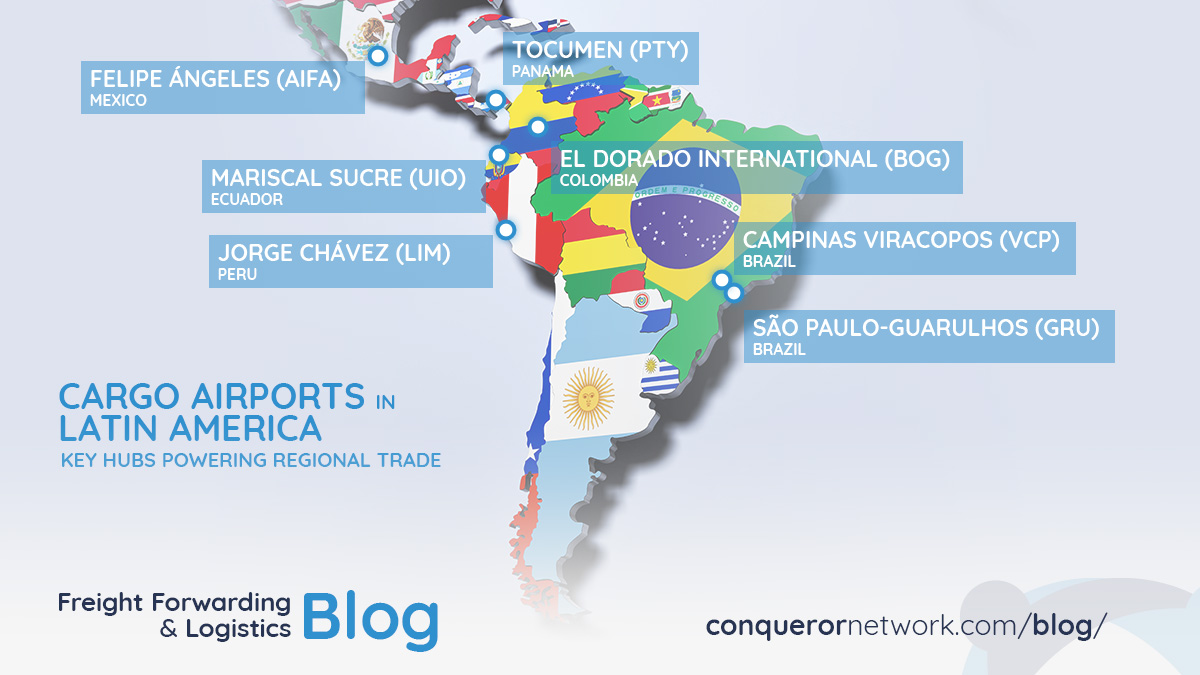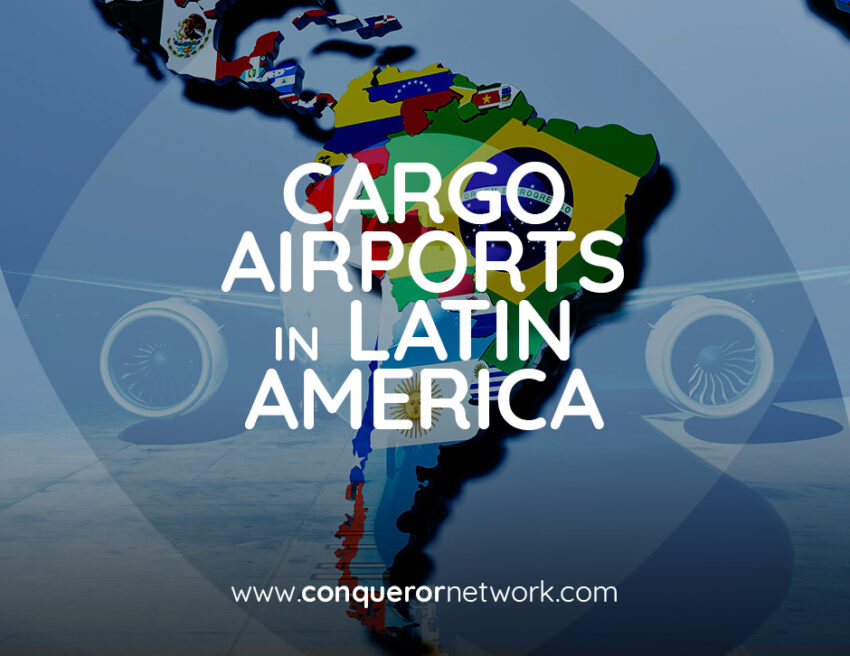Freight forwarders serving the Americas can no longer think of the region’s air network as a peripheral add-on to ocean freight. Today, cargo airports in Latin America handle everything from export flowers and pharmaceuticals to e-commerce parcels on overnight schedules. With volumes rebounding faster than pre-pandemic projections—and with governments racing to upgrade runways, cold-chain rooms, and free-trade zones—these gateways are transforming how independent forwarders plan routings, price capacity, and promise lead-times to customers.
Why Cargo Airports in Latin America Matter to Independent Forwarders
The region’s GDP may be smaller than that of North America or Europe, but its air-cargo profile is outsized and highly specialized:
-
Perishables dominance – Colombia, Ecuador, Peru, and Chile collectively ship more than 1.5 million tonnes of flowers, fruit, seafood, and pharma each year—commodities that depend on airport infrastructure for freight with reliable 2-8 °C corridors.
-
Nearshoring wave – Electronics, auto parts, and high-value textiles are shifting production closer to U.S. markets. Latin America freight hubs that can clear customs in under six hours will win these contracts.
-
E-commerce explosion – Same-day and next-day service expectations are migrating south, driving express integrators to expand cargo terminals in Latin America and sign block-space agreements with regional carriers.

Top Cargo Airports in Latin America and Their Competitive Edge
Below is a forwarder’s field guide to the region’s headline performers. Statistics are 2023-2024 year-end unless otherwise noted.
1. El Dorado International (BOG) — Bogotá, Colombia
-
2024 throughput: 809,000 t, the highest ever recorded
-
Sweet spot: Flowers, perishables, pharma
-
Why it matters: Two 3,800 m runways at 8,360 ft elevation make BOG a purpose-built wide-body freighter hub. Cargo airlines position here to bridge east-west schedules across the Caribbean, giving forwarders same-night connections into MIA, AMS, and DOH.
2. São Paulo-Guarulhos (GRU) — Brazil
-
H1 2024 international cargo: 235,600 tonnes
-
Sweet spot: Automotive, machinery, pharma cold-chain (largest airport cool-store in Brazil)
-
Forwarder tip: High airport fees can be offset by trucking to the Port of Santos in under 90 minutes, enabling true air-sea multimodal products.
3. Campinas Viracopos (VCP) — Brazil
-
Profile: Handles roughly one-third of Brazil’s imported air freight and was voted 2024 Cargo Airport of the Year routesonline.com
-
Edge: 90,000 m² cargo terminal with 11 dedicated cold rooms and a live-animal zone. Ideal for time-critical tech and concert logistics.
4. Felipe Ángeles (AIFA) — Mexico City Metropolitan Area
-
2024 milestone: Surpassed legacy AICM as the country’s top cargo hub after the government-mandated migration of freighters, with new 40,000 m² warehousing under construction reuters.com
-
Forwarder takeaway: Better slot availability and night operations reduce dwell times; integrate truck shuttle to AICM passenger belly capacity for hybrid solutions.
5. Jorge Chávez (LIM) — Lima, Peru
-
2023 freight: 230,993 t en.wikipedia.org
-
Growth driver: Second runway and 2025 inauguration of a new 40 million-passenger terminal with an adjoining logistics park.
-
Cargo focus: Fresh asparagus, blueberries, and salmon; pre-cleared seafood can hit U.S. supermarket shelves within 48 hours of harvest.
6. Mariscal Sucre (UIO) — Quito, Ecuador
-
2023 freight: 335,407 t, up 14 % YoY and now 5th in the region aerolatinnews.com
-
Facility edge: Single-campus cargo logistics center with palletising, bonded storage, and simultaneous parking for six Code E/F freighters.
-
Forwarder strategy: Pair UIO’s flower volumes with northbound charters that return southbound with e-commerce parcels, balancing load factors and rates.
7. Tocumen (PTY) — Panama City, Panama
-
2024 freight: 216,653 t (+4 %) aviacionline.com
-
Why forwarders love it: PTY sits astride the Colon Free Zone and the Panama Canal rail link; a third runway is budgeted at USD 900 million to future-proof capacity trade.gov.
Cargo Terminals in Latin America: What Makes Them Different?
-
Altitude & Climate Engineering
Bogotá and Quito operate at high elevations, necessitating longer runways and derated payloads. Airport infrastructure for freight includes extra-power GPU units and oxygen-enriched cold stores to maintain flower freshness. -
Cold-Chain Certification
Pharma shippers demand IATA CEIV or WHO GDP accreditation. GRU, VCP, and LIM all hold multiple certifications, allowing forwarders to move temperature-controlled cargo without auxiliary containers—a significant cost saving. -
Customs & Free-Zone Synergy
Many airports interface directly with bonded zones or inland ports. PTY’s on-airport logistics park and Panama Pacifico free zone cut transfer times by 24 hours compared with off-site warehousing. -
Digitisation Levels
BOG and GRU have API links to customs single windows, while AIFA uses Mexico’s Ventanilla Única. Forwarders can transmit e-AWBs and obtain release codes before wheels-down, a huge advantage for time-critical shipments.
Emerging Cargo Airports in Latin America You Should Watch
-
Ezeiza (EZE), Buenos Aires: Leveraging perishables to Asia via new Qatar Airways freighters.
-
Recife (REC), Brazil: Northeast auto-parts cluster tapping direct charters to Europe.
-
Manaus (MAO), Brazil: FTZ electronics hub doubling cool-room space for semiconductors.
While their tonnages remain below 150 k t per year, proactive forwarders can lock in block space before the big integrators arrive—an early-mover advantage Conqueror members should not overlook.
Operational Tips for Air Freight in Latin America
-
Book wide-body belly early: Passenger carriers to North America fill weeks ahead in peak perishables season (Jan-Feb for Valentine’s Day, Nov-Dec for Christmas electronics).
-
Check weekend customs hours: Several airports, notably LIM and UIO, run skeleton shifts on Sundays—factor into transit promises.
-
Use ULD pooling partnerships: Reduces empty repositioning fees on imbalanced north-south routes.
-
Watch political changes: Government fee revisions (e.g., Mexico’s AIFA decree) can up-end routings overnight; keep contingency plans ready.
Final Word: A Region on the Rise
From Bogotá’s eight-figure expansion to Panama’s third-runway blueprint, cargo airports in Latin America are writing the next chapter in hemispheric logistics. For independent freight forwarders, these hubs are not just transit points—they are strategic levers to shorten lead times, diversify modal risk, and command premium margins in niche verticals. Conqueror members that map capacities, certify handling partners, and lock in allotments today will be ready to ride tomorrow’s surge in nearshoring and cross-border e-commerce.


